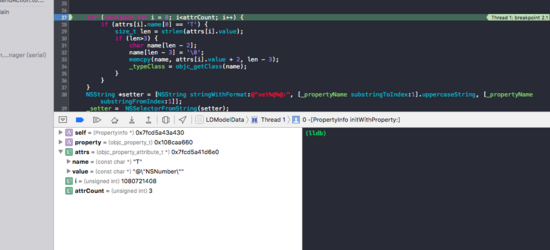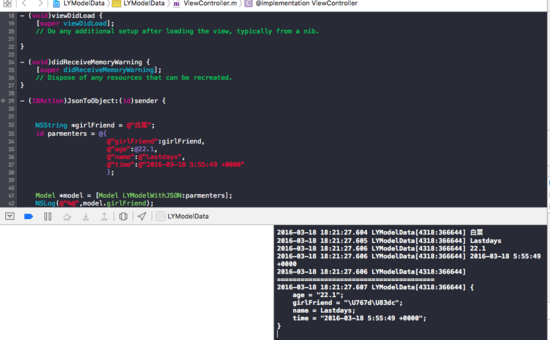观察下面这个JSON数据和Model数据
- NSString *girlFriend = @"白菜";
- id parmenters = @{
- @"girlFriend":girlFriend,
- @"age":@22.1,
- @"name":@"Lastdays",
- @"time":@"2016-03-18 5:55:49 +0000"
- };
- @interfaceModel: NSObject
- @property NSNumber *age;
- @property NSString *name;
- @property NSString *girlFriend;
- @property NSData *time;
- @end
开始的时候仔细想了一下,如何能够动态的去添加属性值,并且根据对应的属性进行赋值,还要保证类型正确,这是我最开始考虑的问题。但是最核心问题就是 动态实现 。
我们一步一步来解决问题,首先我们先获取Model属性,取得Model的一些信息
获取Model属性
runtime提供了 class_copyPropertyList 来获取属性列表,OK,我们可以来看一下用它获取的数据是什么样的?查看runtime源码
- /***********************************************************************
- * class_copyPropertyList. Returns a heap block containing the
- * properties declared in the class, or nil if the class
- * declares no properties. Caller must free the block.
- * Does not copy any superclass's properties.
- **********************************************************************/
- objc_property_t*class_copyPropertyList(Class cls, unsigned int *outCount)
- {
- old_property_list*plist;
- uintptr_titerator = 0;
- old_property**result = nil;
- unsigned int count = 0;
- unsigned int p, i;
- if (!cls) {
- if (outCount) *outCount = 0;
- return nil;
- }
- mutex_locker_tlock(classLock);
- iterator = 0;
- while ((plist = nextPropertyList(cls, &iterator))) {
- count += plist->count;
- }
- if (count > 0) {
- result = (old_property**)malloc((count+1) * sizeof(old_property*));
- p = 0;
- iterator = 0;
- while ((plist = nextPropertyList(cls, &iterator))) {
- for (i = 0; i < plist->count; i++) {
- result[p++] = property_list_nth(plist, i);
- }
- }
- result[p] = nil;
- }
- if (outCount) *outCount = count;
- return (objc_property_t*)result;
- }
- typedef struct old_property*objc_property_t;
- struct old_property {
- const char *name;
- const char *attributes;
- };
从上面的三段runtime源码中,课本上就能判断出,其实返回结果就是一些old_property,并且每个old_property中含有对应的name和其他信息。
总结起来说就是**class_copyPropertyList**获取Model属性列表,属性列表里面的objc_property_t包含着这个属性的类型和名字等一些信息。
根据刚才的分析设计出以下结构:
- bash
- -(id)modelToJsonObject:(NSObject *)model{
- Class cls = self.class;
- unsigned int countProperty = 0;
- objc_property_t*propertys = class_copyPropertyList(cls,&countProperty);
- NSMutableDictionary *dic = [NSMutableDictionary new];
- for (unsigned int i = 0; i<countProperty; i++) {
- PropertyInfo *propertyInfo = [[PropertyInfo alloc]initWithProperty:propertys[i]];
- if (propertyInfo.propertyName!=nil) {
- dic[propertyInfo.propertyName] = [selfLYModelSetJsonObjectWith:modelpropertyInfo:propertyInfo];
- }
- }
- return dic;
- }
PropertyInfo也就是属性信息,我们将Model的所有属性存放到 NSMutableDictionary 中,key就是属性名,Value就是PropertyInfo。
接下来开始获取Model的属性信息 PropertyInfo
我们可以通过property_getName来获取属性名
- const char *property_getName(objc_property_tprop)
- {
- return oldproperty(prop)->name;
- }
接下来就是获取属性的类型和一些其他的信息。获取属性的信息其实和上面的原理差不多,我们使用property_copyAttributeList,
- objc_property_attribute_t*property_copyAttributeList(objc_property_tprop,
- unsigned int *outCount)
- {
- if (!prop) {
- if (outCount) *outCount = 0;
- return nil;
- }
- mutex_locker_tlock(classLock);
- return copyPropertyAttributeList(oldproperty(prop)->attributes,outCount);
- }
看到这里,不往下继续分析源码了,其实可以看到,attributes就是我们想要的信息,其实每个property也是有自己对应的attributes。
这个attributes是什么样呢?翻看源码,找到了答案
- typedef struct {
- const char *name;
- const char *value;
- } objc_property_attribute_t;
加一下断点,看看
可以看到,name是T,Value是NSNumber,我们来获取下NSNumber这个属性类型。
- for (unsigned int i = 0; i<attrCount; i++) {
- if (attrs[i].name[0] == 'T') {
- size_tlen = strlen(attrs[i].value);
- if (len>3) {
- char name[len - 2];
- name[len - 3] = '';
- memcpy(name, attrs[i].value + 2, len - 3);
- _typeClass = objc_getClass(name);
- }
- }
- }
基本上我们想要的信息基本上都已经获取到了,现在接下来就是做动态设定。
中间做个插曲简单的说下Objc是动态语言,[receiver message]的执行过程当中,[receiver message]是会被动态编译的,Objc是动态语言,因此它会想尽办法将编译连接推迟到运行时来做。runtime这个时实运行系统就是来执行编译后的代码。
在这个消息发送过程中,objc_msgSend充当着很重要的角色,所以我们可以主动触发objc_msgSend,来模拟getter,setter方法获取属性值,或者建立。
我们通过SEL来定义选择器,选择器是什么?就是方法名的唯一标识符
根据刚才的想法,编写的代码***是这个样子
- -(instancetype)initWithProperty:(objc_property_t)property{
- _property = property;
- const char *name = property_getName(property);
- if (name) {
- _propertyName = [NSStringstringWithUTF8String:name];
- }
- unsigned int attrCount;
- objc_property_attribute_t*attrs = property_copyAttributeList(property, &attrCount);
- for (unsigned int i = 0; i<attrCount; i++) {
- if (attrs[i].name[0] == 'T') {
- size_tlen = strlen(attrs[i].value);
- if (len>3) {
- char name[len - 2];
- name[len - 3] = '';
- memcpy(name, attrs[i].value + 2, len - 3);
- _typeClass = objc_getClass(name);
- }
- }
- }
- NSString *setter = [NSStringstringWithFormat:@"set%@%@:", [_propertyNamesubstringToIndex:1].uppercaseString, [_propertyNamesubstringFromIndex:1]];
- _setter = NSSelectorFromString(setter);
- _getter = NSSelectorFromString(_propertyName);
- return self;
- }
基本的准备工作,和一些问题都解决了,接下来可以写功能了。
JSON转Model
根据刚才说的,我们可以主动触发objc_msgSend,来模拟setter方法建立属性值。设计出以下方法
- -(void)LYModelSetPropertyWithModel:(id) modelvalue:(id)valuepropertyInfo:(PropertyInfo *) propertyInfo{
- ((void (*)(id, SEL, id))(void *) objc_msgSend)((id)model, propertyInfo.setter, value);
- }
我们将Model的所有属性存放到 NSMutableDictionary 中,key就是属性名,Value就是PropertyInfo。
现在就可以动态设定了
- -(BOOL)LYModelSelectProperties:(NSDictionary *)dictonary{
- ClassInfo *cls = [[ClassInfo alloc]initWithClass:object_getClass(self)];
- id key, value;
- NSArray *keys = [dictonaryallKeys];
- NSUInteger count = [keyscount];
- for (int i = 0; i < count; i++){
- key = [keysobjectAtIndex: i];
- value = [dictonaryobjectForKey: key];
- if (cls.propertyInfo[key]) {
- [selfLYModelSetPropertyWithModel:selfvalue:valuepropertyInfo:cls.propertyInfo[key]];
- }
- }
- return YES;
- }
完成动态设定
Model转JSON
原理跟JSON转Model
我们可以主动触发objc_msgSend,来模拟getter方法来获取属性值。
- -(id)LYModelSetJsonObjectWith:(id)modelpropertyInfo:(PropertyInfo *)propertyInfo{
- id value = ((id (*)(id, SEL))(void *) objc_msgSend)((id)model, propertyInfo.getter);
- return value;
- }
建立NSDictionary
- -(id)modelToJsonObject:(NSObject *)model{
- Class cls = self.class;
- unsigned int countProperty = 0;
- objc_property_t*propertys = class_copyPropertyList(cls,&countProperty);
- NSMutableDictionary *dic = [NSMutableDictionary new];
- for (unsigned int i = 0; i<countProperty; i++) {
- PropertyInfo *propertyInfo = [[PropertyInfo alloc]initWithProperty:propertys[i]];
- if (propertyInfo.propertyName!=nil) {
- dic[propertyInfo.propertyName] = [selfLYModelSetJsonWith:modelpropertyInfo:propertyInfo];
- }
- }
- return dic;
- }
完成获取
测试
- NSString *girlFriend = @"白菜";
- id parmenters = @{
- @"girlFriend":girlFriend,
- @"age":@22.1,
- @"name":@"Lastdays",
- @"time":@"2016-03-18 5:55:49 +0000"
- };
- Model *model = [ModelLYModelWithJSON:parmenters];
- NSLog(@"%@",model.girlFriend);
- NSLog(@"%@",model.name);
- NSLog(@"%@",model.age);
- NSLog(@"%@",model.time);
- NSLog(@"========================================");
- NSDictionary *jsonObject= [modelLYModelToJson];
- NSLog(@"%@",jsonObject);
结果:
总结
简单的JSON Model转换库,关键点就是在于对runtime的理解。就当自己的一个小练习,后续会继续维护,让它对更多类型进行支持。代码结构上可能不是那么好,后续会将整体的结构重新设计下,增加可读性,也欢迎来提出建议。

































